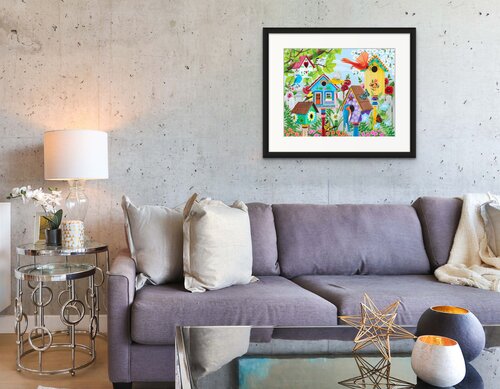by Carolyn Edlund
Want to sell your artwork online directly through your artist website? Start with these basics to impress and convert visitors.

“A Monarch’s Life” mixed media, 20″ x 16″ by Kathy Kehoe Bambeck
Select Your Body of Work
Your art is the heart of your business, and the star of your website. But your body of work doesn’t need to include everything you’ve ever made, or groups of work that are unrelated. A cohesive line of art or handmade items is best for making a memorable impression.
Choose your very best artwork by curating your portfolio carefully. Let go of artwork that doesn’t reflect your best efforts or is no longer a focus of yours. I love to see current work. When I visit an artist website, I want to see what you are making now and the direction you’re going. Exciting new work sends a strong, focused message to visitors. In contrast, a mishmash of different styles, mediums and subjects is confusing and forgettable.
Feature Excellent Photos
Once you have chosen your best work, make sure you have outstanding images of them on your site. It’s astonishing how many artists are willing to let poor photographs represent them. If your photos suffer from over or under-exposure, blurriness, inappropriate backgrounds or other problems, don’t use them. Make sure your artwork is professionally photographed or learn how to take outstanding photos yourself. It’s one of the most important things you can do for your art business. Great photos tell me that you are a professional and that your art has value.

In situ photo of “Birdhouse Garden” mixed media, 20″ x 16″ by Kathy Kehoe Bambeck
When shopping online for clothing or other wearables, notice how vendors provide multiple views that help you virtually try things on. Take a page from this marketing strategy when selling your creative work online. Share visual content that helps shoppers imagine owning your work. Detail shots, in situ photos and multiple views give the customer confidence that they have seen the item fully, and are ready to move forward. When they are completely satisfied with their shopping experience, they are far more likely to buy.
Include Essential Written Content
Your art doesn’t sell itself. When you include vital information that speaks to the prospective customer, and connects with them emotionally, you add yet another dimension to their understanding and appreciation of your work. Construct an About page that tells a compelling artist story, and compose a brand narrative that conveys the Why? behind what you do.
One fine artist put together a specific page on her website that answers the question Why Should You Buy My Work? with a whole list of benefits to the customer. Some of her reasons:
- You are buying directly from the artist – hearing her story, understanding her technique, knowing why it’s special. This adds to the experience of owning her art.
- She uses the highest quality materials – and explains what they are.
- Her work is original and one-of-a-kind. No one else will own that image.
- The value of her work continues to increase over time.
- Owning original art allows you to express yourself creatively and surround yourself with beautiful things.
Her list goes on, with more compelling reasons to buy her art. Clearly this artist has given a lot of thought to answering the question of why people should buy from her. Putting those reasons in writing shares this concretely with potential collectors and adds to their comfort level.
Lead to the Sale
An artist website with ecommerce functionality will contain individual product pages. This is where images with well-written descriptions reside, as well as the shopping cart. Is your print on archival paper? Do you make your jewelry with argentium silver that resists tarnishing? Cover details on the product page and list the features, focusing on the benefit to the customer. Placing this info on the same page with the Buy Now button is a smart marketing practice.
Your website needs a separate page titled FAQ or How to Purchase that provides the customer with logistical answers that directly affect them. How is your work shipped? What are the freight charges? Are packages insured? Do you accept returns? Do you gift wrap? Will you accept a special order? and other questions should be answered fully. Step into the shoes of the prospect and consider: What do they need to know in order to gain the confidence needed to make the purchase? Answer those questions and make it super easy to contact you for anything else.
Ensure Easy Checkout
Without prices and an ecommerce function on your website, it is unlikely that you will sell to online shoppers. People are used to ordering online and they have expectations. Your work should be priced. Offers like free shipping should be prominently placed. Your checkout process should be easy. Don’t expect people to contact you to get a price or discuss a sale; this rarely happens. Instead, the customer will move on to a site with clear information and straightforward ordering, and they will purchase from that artist.
Stay Connected
As a bonus, pull your Instagram feed into your website to keep visitors current on your latest work. These newsworthy posts add an up-to-the-minute view of your art, exhibitions, awards and more. Add a button to encourage them to follow you on social media. Gaining website visitors as social followers puts you in a position to place your artwork in front of them on a regular basis. Repeat exposure is the best way to familiarize people with your art and close sales.

Engage site visitors by incorporating your Instagram feed. Artist credit: Carol Siskind
Develop Customer Relationships
Responsive customer service is another essential element to running an online art business. Reply promptly to emails or phone calls about the work you have for sale. Follow up on sales leads and be prepared to share complete information as needed to assist your customer. You are selling a luxury item which is an emotional purchase. The better your customer service, the more your collectors will appreciate you and refer you to others.
Other artists invite the site visitor to schedule a video call at the touch of a button, designed to discuss the customer’s needs and answers. This is a perfect segue to having a conversation about a commission, or to converse about a large or expensive piece of art. Face to face discussions are powerful, and they have an advantage over depersonalized online transactions. A video call is one step closer to an in-person meeting, which is the gold standard for selling art.
People love to shop, and they love to buy. Sometimes they vacillate and only need one good reason to tip the scales and say Yes to the sale. Make sure you provide what your customer needs to influence their decision when considering a purchase. Professional presentation, thoughtfully written content, and superb customer service can and will sell more of your work.
Artist credit: Kathy Kehoe Bambeck and Carol Siskind


Speak Your Mind